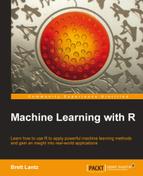- Machine Learning with R
- Table of Contents
- Machine Learning with R
- Credits
- About the Author
- About the Reviewers
- www.PacktPub.com
- Preface
- 1. Introducing Machine Learning
- 2. Managing and Understanding Data
- R data structures
- Vectors
- Factors
- Managing data with R
- Exploring and understanding data
- Exploring the structure of data
- Exploring numeric variables
- Measuring the central tendency – mean and median
- Measuring spread – quartiles and the five-number summary
- Visualizing numeric variables – boxplots
- Visualizing numeric variables – histograms
- Understanding numeric data – uniform and normal distributions
- Measuring spread – variance and standard deviation
- Exploring categorical variables
- Exploring relationships between variables
- Summary
- 3. Lazy Learning – Classification Using Nearest Neighbors
- 4. Probabilistic Learning – Classification Using Naive Bayes
- Understanding naive Bayes
- Example – filtering mobile phone spam with the naive Bayes algorithm
- Summary
- 5. Divide and Conquer – Classification Using Decision Trees and Rules
- Understanding decision trees
- Example – identifying risky bank loans using C5.0 decision trees
- Understanding classification rules
- Example – identifying poisonous mushrooms with rule learners
- Summary
- 6. Forecasting Numeric Data – Regression Methods
- Understanding regression
- Example – predicting medical expenses using linear regression
- Understanding regression trees and model trees
- Example – estimating the quality of wines with regression trees and model trees
- Summary
- 7. Black Box Methods – Neural Networks and Support Vector Machines
- 8. Finding Patterns – Market Basket Analysis Using Association Rules
- 9. Finding Groups of Data – Clustering with k-means
- Understanding clustering
- Clustering as a machine learning task
- The k-means algorithm for clustering
- Finding teen market segments using k-means clustering
- Step 1 – collecting data
- Step 2 – exploring and preparing the data
- Step 3 – training a model on the data
- Step 4 – evaluating model performance
- Step 5 – improving model performance
- Summary
- Understanding clustering
- 10. Evaluating Model Performance
- 11. Improving Model Performance
- 12. Specialized Machine Learning Topics
- Index
In this chapter, we learned about classification using k-nearest neighbors. Unlike many classification algorithms, kNN does not do any learning. It simply stores the training data verbatim. Unlabeled test examples are then matched to the most similar records in the training set using a distance function, and the unlabeled example is assigned the label of its neighbors.
In spite of the fact that kNN is a simple algorithm, it is capable of tackling extremely complex tasks, such as identifying cancerous masses. In a few simple lines of R code, we were able to correctly identify whether a mass was malignant or benign 98 percent of the time.
In the next chapter, we will examine a classification method that uses probability to estimate the likelihood that an observation falls into certain categories. It will be interesting to compare how this approach differs from kNN. Later on, in Chapter 9, Finding Groups of Data – Clustering with k-means, we will learn about a close relative to kNN, which uses distance measures for a completely different learning task.
-
No Comment
